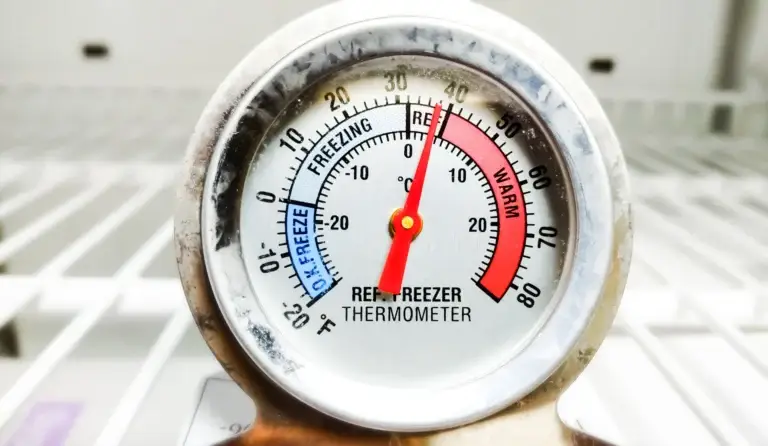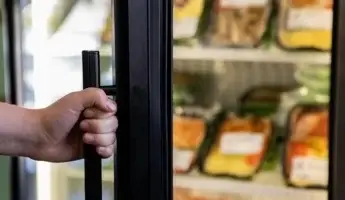Do you need a thermometer in your commercial fridge?
- Fridgesmart

If you run a café, takeaway, convenience store any business that handles food, keeping your refrigeration at the right temperature is the law. The last thing you want to do is make anyone sick from your produce. The FSA has very strict – but reasonable – standards you’re expected to abide by.
But do you actually need a thermometer in your commercial fridge? Well, let’s break it down.
Food safety regulations
UK food safety law requires that chilled food be stored at 5°C or below (the technical safe limit is 8°C, but fridges should be 5°C so there’s a safety buffer). Environmental health officers (EHOs) expect to see that you’re actively monitoring your fridge temperatures. And yes, that means having a reliable thermometer system in place, not just trusting the built-in thermostat.
Without it, you’re open to warnings, fines or even closure if your fridges aren’t storing food at safe levels. And, of course, unsafe temperatures increase the risk of spoilage and foodborne illness, something no business can afford.
Why you can’t just rely on the fridge display
Most commercial fridges, including display fridges, come with digital screens showing internal temperature. These days, those readings are often quite precise (to within plus or minus 1 degree). The potential problem isn’t so much the accuracy, and more the positioning of the sensor. For example, the fridge’s sensor may be located in a cooler part of the fridge, so even if it’s cool, what if it’s warmer in another spot?
Many commercial fridges end up with hotspots near the door or on packed shelves. Here, the temperature can run a few degrees Celsius higher, which could put your produce in the danger zone. And that’s where food safety and compliance problems get very serious very quickly.
A separate thermometer, placed inside the fridge where products actually sit, will give you a much clearer picture. If there are any irregularities, you can investigate them, but we’ll talk more about placement and record-keeping below.
Where to place a fridge thermometer for record-keeping and compliance
Stick your additional thermometer near the middle shelf, away from fans or walls, so you’re measuring the air temperature where food sits. If you only keep it near the door, the readings will fluctuate every time staff open the fridge. And because they might need to open the refrigerator to read the temperature, that doesn’t really work.
For walk-in fridges or larger units, guidance usually recommends checking multiple points, particularly top, middle and bottom, and sometimes door areas, especially if you know your customers or staff open the doors frequently. Prioritise areas higher up and where you tend to store a large amount of produce.
EHOs want to see not just that you’re checking fridge temperatures, but that you’re keeping records. That means daily checks and logs, either on paper or using a digital system. A typical routine is:
- Check fridge temperatures at least once per day (many businesses do twice).
- Write down the reading along with the date, time, and initials of the staff member.
- Note any corrective action if temperatures are too high (e.g., moving food to another fridge, calling for servicing).
Good record-keeping shows you’re in control of food safety and helps protect your business in the event of a complaint or inspection.
Thermometer types you can use
As with everything these days, there are a variety of thermometer options. They’re all valid. Try to pick the most effective ones for your workflow. Here are your three main options:
- Standalone fridge thermometers – small devices you place inside the cabinet. Some are simple dial models, others are digital with memory functions. Make sure dial thermometers are certified for commercial use; some very cheap models might not meet food safety standards.
- Digital probe thermometers – accurate, portable and easy to read.
- Data loggers – these automatically record and store temperature readings with no need for manual reading and logging. They also often come with alarms if levels drift outside safe ranges. They’re particularly useful for larger sites or businesses with multiple fridges, where checking and logging multiple temperatures otherwise requires too much time.
What Fridgesmart recommends
Overall? Yes, you should have an extra thermometer in your commercial fridge. You need a system for compliance, and it’s a great way to make sure you’re keeping all your produce out of the danger zone. It’s peace of mind that your food is safe, and so are your customers.
With the right commercial fridge from Fridgesmart, you get reliable cooling, easy monitoring and peace of mind that your food stays safe and compliant. Explore our service and maintenance options to keep your unit running smoothly, and check out our warranty packages for extra protection.
Whether you’re stocking drinks, chilled meals, or fresh ingredients, Fridgesmart has the right fridge and the expert knowledge your business needs. Get in touch today by calling 01792 677169 or emailing hello@fridgesmart.co.uk.


